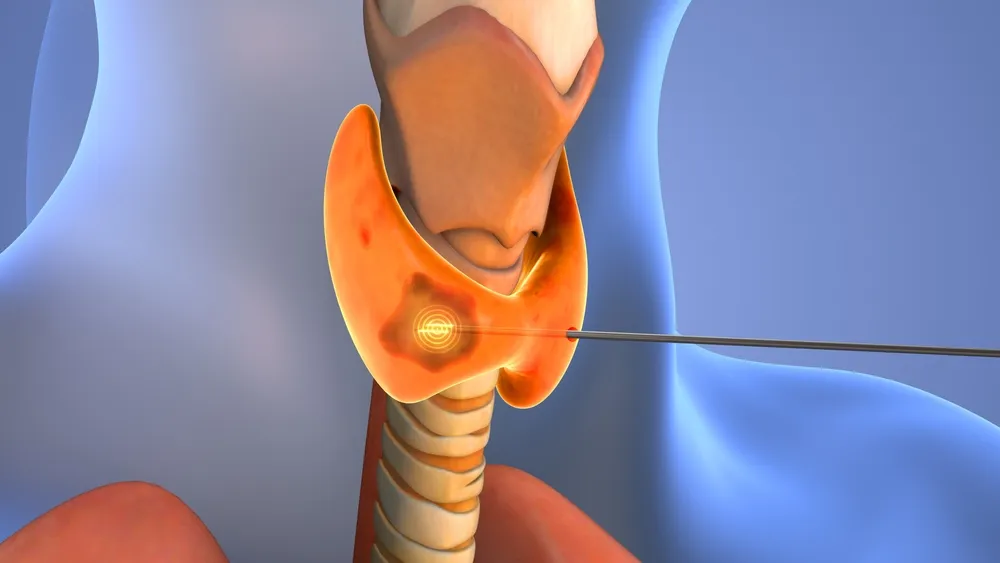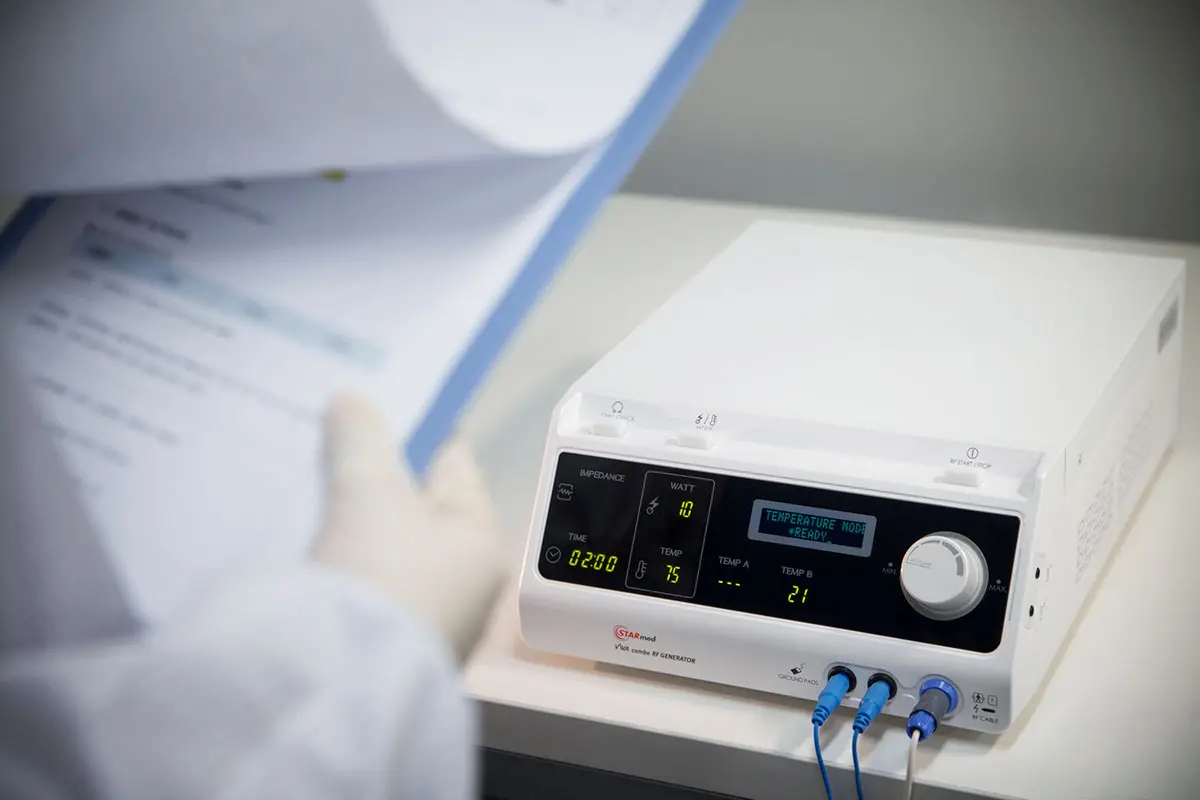TL;DR: Radiofrequency ablation (RFA) is an emerging treatment for benign thyroid nodules and has also shown some promising results for treating cancerous nodules in recent clinical studies, especially for papillary thyroid cancer. Clinicians should understand current guidelines, patient selection criteria, and research outcomes when considering RFA for thyroid cancer treatment as a minimally invasive alternative to surgery for patients who are not the ideal candidates for surgery.
- RFA uses targeted heat to destroy thyroid tissue without surgery.
- Recent clinical outcomes for RFA of thyroid cancer show promising outcomes, especially for small, low-risk papillary tumors.
- Ideal candidates include patients with small, intrathyroidal cancers who decline or cannot undergo surgery.
- RFA is also effective for recurrent papillary thyroid cancer in lymph nodes.
- U.S. guidelines are evolving as more data supports the safety and efficacy of RFA for thyroid cancer.
- Early adopters are helping shape the future of minimally invasive thyroid cancer care.
Can radiofrequency ablation (RFA) treat thyroid cancer? This question is increasingly on clinicians’ minds as interest grows in less invasive alternatives to surgery for thyroid tumors.
RFA for thyroid cancer is a relatively new approach in the United States for patients who may not be ideal candidates for traditional treatment or patients who refuse surgery. The treatment uses targeted thermal energy to destroy thyroid tissue. At present, RFA is commonly used as the treatment for benign thyroid nodules. It provides an efficacious alternative to surgery without damaging healthy thyroid tissue.
Research on using RFA for thyroid cancer treatment looks promising, but there is still a lot to learn. In this blog, we’ll provide an overview of RFA for thyroid cancer, particularly papillary thyroid cancer. Our goal is to offer insight grounded in recent studies into whether RFA can play a role in treating thyroid cancer.
Continue reading to learn the current status of this minimally invasive treatment modality.
Radiofrequency Ablation (RFA) for Thyroid Cancer
Radiofrequency ablation is a minimally invasive treatment that uses a high-frequency electrical current to generate heat and destroy targeted tissue. In the thyroid, RFA is performed by inserting a thin electrode needle into the nodule under ultrasound guidance. It’s then heated to ablate the nodule.
This technique has been used for years in other organs, as well as for benign thyroid nodules. Today, RFA is being explored for the treatment of malignant thyroid nodules as well.
The appeal of RFA in the thyroid is that it can destroy a thyroid tumor without requiring surgery. As a result, it can preserve the rest of the thyroid gland and minimize recovery time.
Clinically, radiofrequency ablation for thyroid cancer is being considered for small, localized cancers and for certain recurrent thyroid cancers. Internationally, doctors have been using RFA for thyroid malignancies for over a decade, reporting promising outcomes.
Early adopters in the United States have begun performing RFA on thyroid tumors as part of clinical studies. Still, it’s important to understand the regulatory status and guidelines before adopting radiofrequency ablation thyroid cancer treatments.
FDA Clearance and U.S. Guidelines: Benign vs Malignant Nodules

In the United States, radiofrequency ablation devices, including STARmed’s technology, are FDA-cleared for general soft tissue ablation. However, this clearance is for the equipment itself, not for any specific procedure or disease state. How it’s applied clinically depends on current guidelines and physician judgment.
The ATA currently provides guidance on using RFA to treat benign thyroid nodules, particularly those that are symptomatic or cosmetically concerning. These guidelines support RFA as a safe and effective minimally invasive option for shrinking benign nodules and preserving thyroid function.
However, the ATA has not yet issued any formal guidelines for the use of RFA in treating malignant thyroid nodules. Despite this, a growing number of pioneering physicians are expanding the clinical applications of thyroid RFA. For patients who are not ideal candidates for surgery or who decline surgical treatment, RFA is being used to ablate malignant nodules with promising results.
As research evolves and clinical data accumulates, guidelines and regulatory frameworks may expand to formally address the use of RFA for malignant thyroid disease. Until then, any use of RFA for thyroid cancer should be approached carefully.
Is RFA Approved for Benign Thyroid Nodules?
Yes, RFA is an established option for benign nodules in the United States. It has demonstrated success in shrinking benign goiters by 70–90% in volume at five years post-treatment.
Patient Selection: Who Is a Candidate for RFA in Thyroid Cancer?
Because RFA is not yet the standard approach for thyroid cancer, proper patient selection is critical. At present, only a small subset of thyroid cancer patients may be appropriate for RFA. Specifically, those with small, low-risk tumors and favorable features may be candidates.
Right now, thyroid cancer RFA is only being offered to patients who are not ideal for surgery or who have refused surgery.
Here are the typical selection criteria and clinical guidelines for using RFA in thyroid cancer:
- Single, small, low-risk papillary carcinoma
- No extrathyroidal extension or metastasis
- Indolent tumor behavior
- Patients at high surgical risk, refuse surgery, or strongly prefer to avoid it
- Nodule accessible to RFA
- Confirmed pathology
In essence, the ideal profile is a patient with a single, small intrathyroidal papillary carcinoma with no spread. Likewise, the ideal patient either cannot undergo or does not want surgery.
RFA is currently reserved for well-selected patients who have the smallest, least aggressive thyroid cancers. In fact, data on using RFA for primary thyroid cancers larger than 1 cm is scarce. Likewise, the role of RFA for microcarcinomas, while very promising, is still under investigation and somewhat “controversial” in guidelines.
If a patient does not meet these low-risk criteria, surgery remains the recommended course.
RFA for Papillary Thyroid Cancer
The exception may be recurrent thyroid cancer. RFA has emerged as an effective tool for recurrent papillary thyroid cancer in lymph nodes.
A recent North American study treated dozens of PTC lymph node metastases with RFA. They achieved a median volume reduction of ~80% and biochemical response in most patients. In that study, they observed only minimal complications.
Enter a New Era of RFA Treatment for Thyroid Cancer
RFA for thyroid cancer is not yet mainstream in the United States. However, the clinical evidence from the past five years has been overwhelmingly positive. Early adopters are actively demonstrating its value in real-world practice. For clinicians, this means it’s time to pay attention to RFA a viable option for thyroid tumor management.
If you’re a clinician interested in implementing RFA for thyroid nodules, we encourage you to explore our solutions. Together, we can offer a treatment that is not only effective but also more patient-centric.





